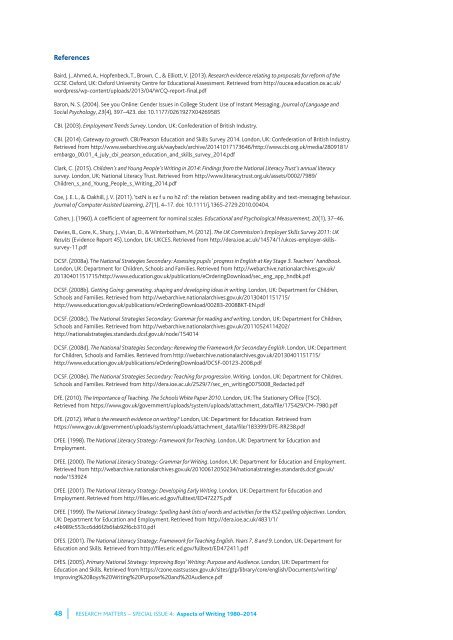Research Matters
N6fqJH
N6fqJH
You also want an ePaper? Increase the reach of your titles
YUMPU automatically turns print PDFs into web optimized ePapers that Google loves.
References<br />
Baird, J.,Ahmed,A., Hopfenbeck,T., Brown, C., & Elliott,V. (2013). <strong>Research</strong> evidence relating to proposals for reform of the<br />
GCSE. Oxford, UK: Oxford University Centre for Educational Assessment. Retrieved from http://oucea.education.ox.ac.uk/<br />
wordpress/wp-content/uploads/2013/04/WCQ-report-final.pdf<br />
Baron, N. S. (2004). See you Online: Gender Issues in College Student Use of Instant Messaging. Journal of Language and<br />
Social Psychology, 23(4), 397–423. doi: 10.1177/0261927X04269585<br />
CBI. (2003). Employment Trends Survey. London, UK: Confederation of British Industry.<br />
CBI. (2014). Gateway to growth. CBI/Pearson Education and Skills Survey 2014. London, UK: Confederation of British Industry.<br />
Retrieved from http://www.webarchive.org.uk/wayback/archive/20141017173646/http://www.cbi.org.uk/media/2809181/<br />
embargo_00.01_4_july_cbi_pearson_education_and_skills_survey_2014.pdf<br />
Clark, C. (2015). Children’s and Young People’s Writing in 2014: Findings from the National Literacy Trust’s annual literacy<br />
survey. London, UK: National Literacy Trust. Retrieved from http://www.literacytrust.org.uk/assets/0002/7989/<br />
Children_s_and_Young_People_s_Writing_2014.pdf<br />
Coe, J. E. L., & Oakhill, J.V. (2011).‘txtN is ez f u no h2 rd’: the relation between reading ability and text-messaging behaviour.<br />
Journal of Computer Assisted Learning, 27(1), 4–17. doi: 10.1111/j.1365-2729.2010.00404.<br />
Cohen, J. (1960).A coefficient of agreement for nominal scales. Educational and Psychological Measurement, 20(1), 37–46.<br />
Davies, B., Gore, K., Shury, J.,Vivian, D., & Winterbotham, M. (2012). The UK Commission’s Employer Skills Survey 2011: UK<br />
Results (Evidence Report 45). London, UK: UKCES. Retrieved from http://dera.ioe.ac.uk/14574/1/ukces-employer-skillssurvey-11.pdf<br />
DCSF. (2008a).The National Strategies Secondary: Assessing pupils' progress in English at Key Stage 3. Teachers' handbook.<br />
London, UK: Department for Children, Schools and Families. Retrieved from http://webarchive.nationalarchives.gov.uk/<br />
20130401151715/http://www.education.gov.uk/publications/eOrderingDownload/sec_eng_app_hndbk.pdf<br />
DCSF. (2008b). Getting Going: generating, shaping and developing ideas in writing. London, UK: Department for Children,<br />
Schools and Families. Retrieved from http://webarchive.nationalarchives.gov.uk/20130401151715/<br />
http://www.education.gov.uk/publications/eOrderingDownload/00283-2008BKT-EN.pdf<br />
DCSF. (2008c). The National Strategies Secondary: Grammar for reading and writing. London, UK: Department for Children,<br />
Schools and Families. Retrieved from http://webarchive.nationalarchives.gov.uk/20110524114202/<br />
http://nationalstrategies.standards.dcsf.gov.uk/node/154014<br />
DCSF. (2008d). The National Strategies Secondary: Renewing the Framework for Secondary English. London, UK: Department<br />
for Children, Schools and Families. Retrieved from http://webarchive.nationalarchives.gov.uk/20130401151715/<br />
http://www.education.gov.uk/publications/eOrderingDownload/DCSF-00123-2008.pdf<br />
DCSF. (2008e). The National Strategies Secondary: Teaching for progression. Writing. London, UK: Department for Children,<br />
Schools and Families. Retrieved from http://dera.ioe.ac.uk/2529/7/sec_en_writing0075008_Redacted.pdf<br />
DfE. (2010). The Importance of Teaching. The Schools White Paper 2010. London, UK:The Stationery Office (TSO).<br />
Retrieved from https://www.gov.uk/government/uploads/system/uploads/attachment_data/file/175429/CM-7980.pdf<br />
DfE. (2012). What is the research evidence on writing? London, UK: Department for Education. Retrieved from<br />
https://www.gov.uk/government/uploads/system/uploads/attachment_data/file/183399/DFE-RR238.pdf<br />
DfEE. (1998). The National Literacy Strategy: Framework for Teaching. London, UK: Department for Education and<br />
Employment.<br />
DfEE. (2000). The National Literacy Strategy: Grammar for Writing. London, UK: Department for Education and Employment.<br />
Retrieved from http://webarchive.nationalarchives.gov.uk/20100612050234/nationalstrategies.standards.dcsf.gov.uk/<br />
node/153924<br />
DfEE. (2001). The National Literacy Strategy: Developing Early Writing. London, UK: Department for Education and<br />
Employment. Retrieved from http://files.eric.ed.gov/fulltext/ED472275.pdf<br />
DfEE. (1999). The National Literacy Strategy: Spelling bank lists of words and activities for the KS2 spelling objectives. London,<br />
UK: Department for Education and Employment. Retrieved from http://dera.ioe.ac.uk/4831/1/<br />
c4b989c553cc6dd6f2b6fab92f6cb310.pdf<br />
DfES. (2001). The National Literacy Strategy: Framework for Teaching English. Years 7, 8 and 9. London, UK: Department for<br />
Education and Skills. Retrieved from http://files.eric.ed.gov/fulltext/ED472411.pdf<br />
DfES. (2005). Primary National Strategy: Improving Boys’ Writing: Purpose and Audience. London, UK: Department for<br />
Education and Skills. Retrieved from https://czone.eastsussex.gov.uk/sites/gtp/library/core/english/Documents/writing/<br />
Improving%20Boys%20Writing%20Purpose%20and%20Audience.pdf<br />
48 | RESEARCH MATTERS – SPECIAL ISSUE 4: Aspects of Writing 1980–2014


